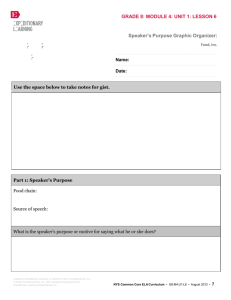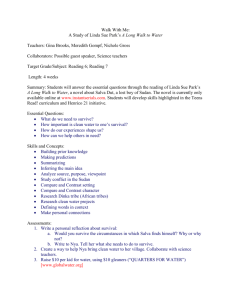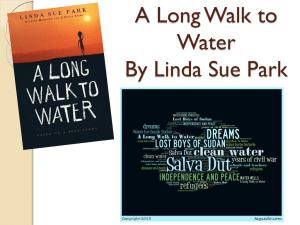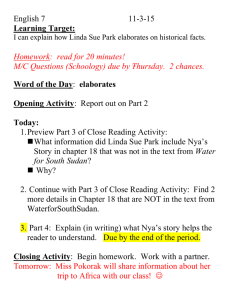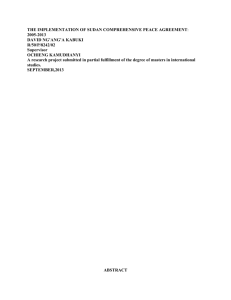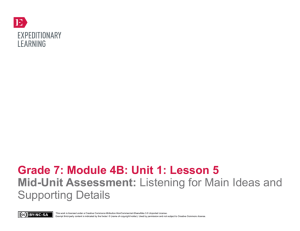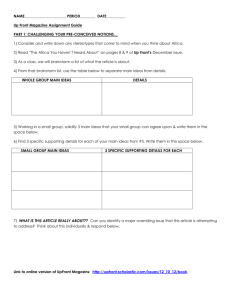Grade 7 ELA Module 1, Unit 2, Lesson 9
advertisement
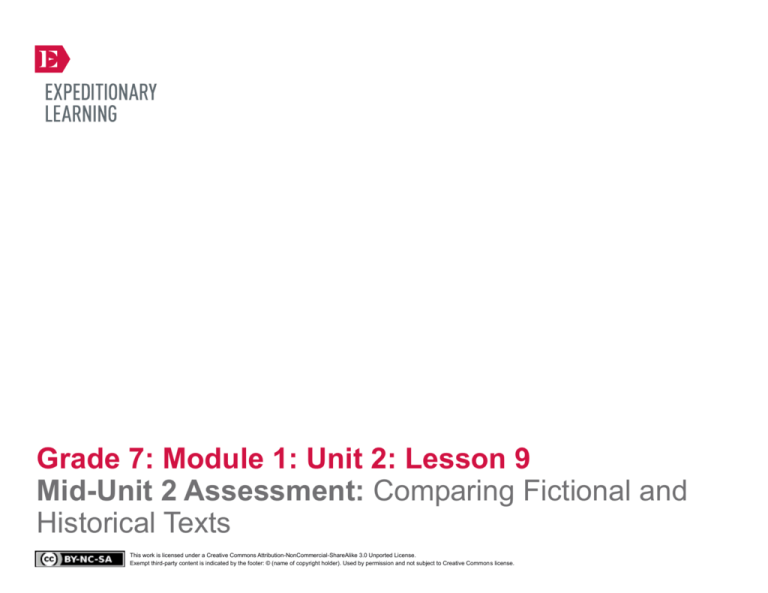
Grade 7: Module 1: Unit 2: Lesson 9 Mid-Unit 2 Assessment: Comparing Fictional and Historical Texts This work is licensed under a Creative Commons Attribution-NonCommercial-ShareAlike 3.0 Unported License. Exempt third-party content is indicated by the footer: © (name of copyright holder). Used by permission and not subject to Creative Commons license. GRADE 7: MODULE 1: UNIT 2: LESSON 9 Mid-Unit 2 Assessment: Comparing Fictional and Historical Texts Long-Term Targets Addressed (Based on NYSP12 ELA CCLS) I can cite several pieces of evidence to support an analysis of informational text. (RI.7.1) I can cite several pieces of text-based evidence to support an analysis of informational text. (RL.7.1) I can analyze how authors of fiction use or alter history based on my comparison of a fictional and historical account of the same time, place, or character. (RL.7.9) Supporting Learning Targets Ongoing Assessment • I can explain how Water for South Sudan involves Sudanese villagers in the process of drilling wells, and the effects that drilling a well can have on a village. • Water for South Sudan Homework Assignment (textdependent questions) • I can explain how the author of A Long Walk to Water both used and altered history (based on my comparison of the novel and Water for South Sudan’s website). • Mid-Unit 2 Assessment Agenda Teaching Notes 1. Opening • This lesson gives students background information that helps them better understand Nya’s story. It includes the Mid-Unit 2 Assessment, which evaluates students’ ability to explain how and why the novel’s author both used and altered historical facts. The standard, RL 7.9, uses the language of “alter” history. It is worth noting that author Linda Sue Park seldom alters facts; rather, she more often elaborates on or imagines details about historical facts. Students practiced these skills in Lessons 6 and 7. A. Vocabulary Entry Task (5 minutes) 2. Work Time A. Discussing Water for South Sudan Homework Assignment: Text-Dependent Questions (15 minutes) B. Mid-Unit 2 Assessment (20 minutes) 3. Closing and Assessment A. Turn and Talk (5 minutes) 4. Homework A. Vocabulary Review • Notice that students do not have a portion of the novel due today, since they completed it for Lesson 8, but the beginning routine of the class remains similar, with a review of vocabulary from the informational text they read. The review of learning targets is brief and folded into Work Time. • By this point, students have met at least once with each discussion partner. Starting at this point, when lesson plans call for the use of the Discussion Appointment protocol, they do not indicate which Discussion Appointment to use; you will decide. It is useful to try to rotate through the Discussion Appointments to give students the opportunity to discuss their ideas with a range of classmates. • In advance: Review the Water for South Sudan reading. • Explore the waterforsouthsudan.org website and make sure the video loads correctly. Prepare necessary Created by Expeditionary Learning, on behalf of Public Consulting Group, Inc. © Public Consulting Group, Inc., with a perpetual license granted to Expeditionary Learning Outward Bound, Inc. NYS Common Core ELA Curriculum • G7:M1:U2:L9 • June 2014 • 1 GRADE 7: MODULE 1: UNIT 2: LESSON 9 Mid-Unit 2 Assessment: Comparing Fictional and Historical Texts Agenda Teaching Notes (continued) • Explore the waterforsouthsudan.org website and make sure the video loads correctly. Prepare necessary technology. • Decide which Discussion Appointment students will use today. • Decide appropriate options for students who finish the assessment early. • Consider whether there are students who should review the homework assignment in a small guided reading group with you, rather than with a partner. • Post: learning targets, vocabulary entry task. Lesson Vocabulary Materials advocate; mission, transform, empower, principle, renewed (from waterforsouthsudan.org) • Vocabulary Entry Task (one per student) • Discussion Appointments in Salva’s Africa (from Lesson 1) • Document camera • Reading Closely: Guiding Questions handout (from Lesson 2) • Mid-Unit 2 Assessment: Comparing “Water for South Sudan” and A Long Walk to Water (one per student) • Mid-Unit 2 Assessment: Comparing “Water for South Sudan” and A Long Walk to Water (Answers and Sample Responses for Teacher Reference) • A Long Walk to Water (book; one per student) • Vocabulary Review homework (one per student) Created by Expeditionary Learning, on behalf of Public Consulting Group, Inc. © Public Consulting Group, Inc., with a perpetual license granted to Expeditionary Learning Outward Bound, Inc. NYS Common Core ELA Curriculum • G7:M1:U2:L9 • June 2014 • 2 GRADE 7: MODULE 1: UNIT 2: LESSON 9 Mid-Unit 2 Assessment: Comparing Fictional and Historical Texts Opening Meeting Students’ Needs A. Vocabulary Entry Task (5 minutes) • Post the Vocabulary Entry Task in advance: “Take out your homework and compare the definitions you wrote in the right-hand column with the ones below, and then correct your paper as necessary.” • This turn and talk provides students with the opportunity to connect words that are critical to the assessment to their own experiences. – Mission: purpose – Transform: completely change – Empower: give someone more control over their own life – Principle: a belief about what is right or wrong – Renewed: feeling strong and able to start again • When you and your partner are finished, discuss these questions: * “What is an experience that has transformed you?” * “What is an experience that has empowered you?” • Ask students to put their Water for South Sudan Homework Assignment out on the desk so you can check it. Do not pick it up, since they will need it during the lesson. Created by Expeditionary Learning, on behalf of Public Consulting Group, Inc. © Public Consulting Group, Inc., with a perpetual license granted to Expeditionary Learning Outward Bound, Inc. NYS Common Core ELA Curriculum • G7:M1:U2:L9 • June 2014 • 3 GRADE 7: MODULE 1: UNIT 2: LESSON 9 Mid-Unit 2 Assessment: Comparing Fictional and Historical Texts Work Time Meeting Students’ Needs A. Discussing Water for South Sudan Homework Assignment: Text-Dependent Questions (15 minutes) • Direct students’ attention to the learning target: • Making sure that all students have the opportunity to make meaning of this text before they are assessed ensures that the assessment is primarily of the standard, RL 7.9, and not primarily of their ability to independently make meaning of complex text. * “I can explain how the author of A Long Walk to Water both used and altered history (based on my comparison of the novel and Water for South Sudan’s website).” • Remind them that they have practiced this skill before (with Salva’s story and the article about Sudan) and tell them that after they have a chance to talk about the reading they did for homework, they will have an assessment of this skill, using the reading they did the previous evening. • Tell students that they will have the opportunity to discuss the Water for South Sudan Homework Assignment with a classmate. They should review their homework and make sure that they both understand the answers to all the questions. • Remind students of their work with the Reading Closely: Guiding Questions handout. Remind them that this document helps connect all of the different skills strong readers use, and tell them that readers use these skills both with novels, which they have been doing, and with informational text, which is what they are discussing today. Encourage them to use the same close reading skills when discussing this text that you have seen them use in discussing the novel. • During Work Time A, you may want to pull struggling readers to review the homework in a small group with you, focusing on Excerpt 2 to ensure that they have understood the text on which the assessment centers. • Remind students of the expectations for the Discussion Appointment protocol and direct them to find their Discussion Appointment (you select which appointment: Juba, Kenya, Ethiopia, Khartoum, White Nile). • After students have worked for 10 minutes, cold call several to explain their answers, especially to the questions for Excerpt 2. If possible, scribe strong answers on a blank form on a document camera. Prompt students to correct their work as necessary. You can leave this up during the assessment. • Thank students for their participation and ask them to return to their seats and clear their desks for the Mid-Unit 2 Assessment. Created by Expeditionary Learning, on behalf of Public Consulting Group, Inc. © Public Consulting Group, Inc., with a perpetual license granted to Expeditionary Learning Outward Bound, Inc. NYS Common Core ELA Curriculum • G7:M1:U2:L9 • June 2014 • 4 GRADE 7: MODULE 1: UNIT 2: LESSON 9 Mid-Unit 2 Assessment: Comparing Fictional and Historical Texts Work Time (continued) Meeting Students’ Needs B. Mid-Unit 2 Assessment (20 minutes) • Tell students that today they get to demonstrate their progress on the learning target that was discussed earlier. Assure students that there are no tricks to this assessment; it really is the exact process they’ve been practicing in class in Lessons 6 and 7. • For some students, this assessment may require more than the 20 minutes allotted. Consider providing students time over multiple days if necessary. It is also possible to shorten the number of responses. To do this, cross out the bottom row on each chart. All students need to show their thinking on both charts. • Tell students that everyone needs to remain silent until the entire class is finished, that this commitment is how they show respect for each other and it is non-negotiable. Write on the board, “If you finish early, you can …” and include suggestions they made in Unit 1 (Lesson 14). • Distribute the Mid-Unit 2 Assessment: Comparing “Water for Sudan” and A Long Walk to Water to each student. • Ask students to begin work on the assessment. Circulate as needed to ensure students are on task and answer any questions regarding the directions for the assessment. • Collect students’ assessments. Created by Expeditionary Learning, on behalf of Public Consulting Group, Inc. © Public Consulting Group, Inc., with a perpetual license granted to Expeditionary Learning Outward Bound, Inc. • Use your professional judgment with regard to Section III of the assessment. This question will be particularly difficult for students who struggle to explain complex ideas in writing, and a weak answer may indicate more about their writing than about their understanding of standard RL 7.9. Options include: asking for oral answers from some students; making success with this item the criteria for an “advanced” as opposed to “proficient” score on the assessment; removing it for all students and substituting a ThinkPair-Share about that question. NYS Common Core ELA Curriculum • G7:M1:U2:L9 • June 2014 • 5 GRADE 7: MODULE 1: UNIT 2: LESSON 9 Mid-Unit 2 Assessment: Comparing Fictional and Historical Texts Closing and Assessment Meeting Students’ Needs Turn and Talk (5 minutes) • Explain the following scenario: “Your little brother is in fourth grade, and he is learning about the U.S. Civil War. He comes home grumbling from school one day. ‘Can you believe it? My teacher says I have to read TWO things—this novel about a soldier in the Civil War and this article about camp life and battle strategies in the Civil War. I don’t get it. Why can’t I just read one thing?’” • Consider posting this scenario and the turn and talk questions on the board. • Ask students to turn and talk: * “What would you tell your brother? How does reading informational text and a novel help you understand a topic better?” • After several minutes, invite a few students to share something their partner said. Reinforce the relationship between reading informational text and reading historical fiction. • Distribute the Vocabulary Review homework and explain the directions. As time permits, ask students to do the first one to make sure they understand how to do the task. Meeting Students’ Needs Homework • See Vocabulary Review homework. Rewrite the sentences from A Long Walk to Water in your own words. Make sure you are correctly explaining the underlined words. The page number after each sentence indicates the page in the book where you can find the sentence. Let’s look at the example on your homework sheet: 5. Salva shook with terror inside and out. (40) Salva was very scared. Created by Expeditionary Learning, on behalf of Public Consulting Group, Inc. © Public Consulting Group, Inc., with a perpetual license granted to Expeditionary Learning Outward Bound, Inc. NYS Common Core ELA Curriculum • G7:M1:U2:L9 • June 2014 • 6 Grade 7: Module 1: Unit 2: Lesson 9 Supporting Materials This work is licensed under a Creative Commons Attribution-NonCommercial-ShareAlike 3.0 Unported License. Exempt third-party content is indicated by the footer: © (name of copyright holder). Used by permission and not subject to Creative Commons license. GRADE 7: MODULE 1: UNIT 2: LESSON 9 Vocabulary Entry Task: Lesson 9 Name: Date: Take out your homework and compare the definitions you wrote in the right hand column with the ones below, and then correct your paper as necessary. Mission: purpose Transform: completely change Empower: give someone more control over their own life Principle: a belief about what is right or wrong Renewed: feeling strong and able to start again When you and your partner are finished, discuss these questions: “What is an experience that has transformed you?” “What is an experience that has empowered you?” Created by Expeditionary Learning, on behalf of Public Consulting Group, Inc. © Public Consulting Group, Inc., with a perpetual license granted to Expeditionary Learning Outward Bound, Inc. NYS Common Core ELA Curriculum • G7:M1:U2:L9 • June 2014 • 8 GRADE 7: MODULE 1: UNIT 2: LESSON 9 Mid-Unit 2 Assessment: Comparing “Water for Sudan” and A Long Walk to Water Name: Date: Directions: For this assessment, reread the text below, then follow the directions about how to show your thinking. The underlined sentences are referred to specifically in the assessment. Water for Sudan: What We Do http://waterforsudan.org/empowering-villages/ South Sudan is not as well-known as Sudan’s Darfur region but its people have much in common with their fellow Sudanese in that region: a harsh desert climate, a war-ravaged environment, and lack of safe, drinkable water. Before South Sudan gained independence in 2011, both were part of Africa’s largest country, and The Republic of South Sudan is now one of the world’s poorest. As of May 2012, Water for South Sudan has drilled 137 borehole wells in South Sudan, bringing clean, safe water to tens of thousands of people in remote villages. A single well may serve several thousand people. People in the villages where Water for South Sudan operates become partners in the process of making safe, drinkable water available there. Villagers provide free, “sweat equity” labor, from unloading trucks and carrying supplies to lugging heavy bags of rocks then pounding them into needed gravel. Village elders help determine a well’s location and appoint one of their people to maintain the completed well and its pump. The Water for South Sudan team trains that well manager and provides spare parts. The result is a village renewed by its own efforts with increased confidence that its people can continue to transform their own lives. Text © Water for South Sudan, Inc. Used by permission. Created by Expeditionary Learning, on behalf of Public Consulting Group, Inc. © Public Consulting Group, Inc., with a perpetual license granted to Expeditionary Learning Outward Bound, Inc. NYS Common Core ELA Curriculum • G7:M1:U2:L9 • June 2014 • 9 GRADE 7: MODULE 1: UNIT 2: LESSON 9 Mid-Unit 2 Assessment: Comparing “Water for Sudan” and A Long Walk to Water I. How did Park use information about Water for Sudan in her book? Directions: Fill out the chart below. The first row has been completed for you as an example. Excerpts from the text “Water for Sudan” How the author of A Long Walk to Water shows this in Nya’s story (The number in parentheses refers to the chapters in the novel that you should reread. Just reread Nya’s story, not the whole chapter.) A single well may serve several thousand people. (18) When the well is opened, Nya explains that no one was to be turned away and that people from miles around, as well as people from her village, would use the well. As a result, the well would serve many more people than just the ones who lived in Nya’s village. People in the villages where (10, 12) Water for South Sudan operates become partners in the process of making safe, drinkable water available there. The result is a village renewed by its own efforts with increased confidence that its people can continue to transform their own lives. (17, 18) Text © Water for South Sudan, Inc. Used by permission. Created by Expeditionary Learning, on behalf of Public Consulting Group, Inc. © Public Consulting Group, Inc., with a perpetual license granted to Expeditionary Learning Outward Bound, Inc. NYS Common Core ELA Curriculum • G7:M1:U2:L9 • June 2014 • 10 GRADE 7: MODULE 1: UNIT 2: LESSON 9 Mid-Unit 2 Assessment: Comparing “Water for Sudan” and A Long Walk to Water II. How did Park elaborate on historical facts in her novel? Directions: Reread Chapter 18 (Nya’s Story), which tells about the opening of the well. What are two details in this chapter that show how Park added to the historical facts? Why does she include these details? What do they help the reader understand? Show your thinking in the chart below. The first row is already done as an example. Details from Chapter 18 about the opening of the well that are NOT in text from waterforsouthsudan.org? Why does the author include this detail? What does it help the reader understand? The well includes a gravel foundation and a pump and is made using concrete. To get water out of the well, people moved a handle up and down. Park includes this because it helps the readers to better understand what Nya saw that day and what it was like for her to use the well. A description of Nya operating the well makes it easier for readers to imagine the well than simply writing that the well was there and had a pump handle. Created by Expeditionary Learning, on behalf of Public Consulting Group, Inc. © Public Consulting Group, Inc., with a perpetual license granted to Expeditionary Learning Outward Bound, Inc. NYS Common Core ELA Curriculum • G7:M1:U2:L9 • June 2014 • 11 GRADE 7: MODULE 1: UNIT 2: LESSON 9 Mid-Unit 2 Assessment: Comparing “Water for Sudan” and A Long Walk to Water III. How did Park add to the historical facts in her novel? Nya is not a historical character; Park created her. In a book otherwise based so closely on facts, why did Park add to history in this way? What does Nya’s story help the reader understand? Created by Expeditionary Learning, on behalf of Public Consulting Group, Inc. © Public Consulting Group, Inc., with a perpetual license granted to Expeditionary Learning Outward Bound, Inc. NYS Common Core ELA Curriculum • G7:M1:U2:L9 • June 2014 • 12 GRADE 7: MODULE 1: UNIT 2: LESSON 9 Mid-Unit 2 Assessment: Comparing “Water for Sudan” and A Long Walk to Water (Answers and Sample Responses for Teacher Reference) I. How did Park use information about Water for Sudan in her book? Directions: Fill out the chart below. The first row has been completed for you as an example. Excerpts from the text “Water for Sudan” How the author of A Long Walk to Water shows this in Nya’s story (The number in parentheses refers to the chapters in the novel that you should reread. Just reread Nya’s story, not the whole chapter.) A single well may serve several thousand people. (18) When the well is opened, Nya explains that no one was to be turned away and that people from miles around, as well as people from her village, would use the well. As a result, the well would serve many more people than just the ones who lived in Nya’s village. People in the villages where Water for South Sudan operates become partners in the process of making safe, drinkable water available there. (10, 12) The result is a village renewed by its own efforts with increased confidence that its people can continue to transform their own lives. (17, 18) Nya’s uncle, who is the chief in the village, helps the drilling team decide where to put the well. Later, Nya’s mother and other women carry rocks to the well, and then other villagers break them up into gravel. Many people in the village help to build the well. People in Nya’s village feel very hopeful because of the well. Her father and some other men decide to build a school. Once there is a well, children will be able to go to school instead of carrying water all the time. They also decide to build a clinic. Having the well makes it possible for the people of Nya’s village to change their lives in many ways. Created by Expeditionary Learning, on behalf of Public Consulting Group, Inc. © Public Consulting Group, Inc., with a perpetual license granted to Expeditionary Learning Outward Bound, Inc. NYS Common Core ELA Curriculum • G7:M1:U2:L9 • June 2014 • 13 GRADE 7: MODULE 1: UNIT 2: LESSON 9 Mid-Unit 2 Assessment: Comparing “Water for Sudan” and A Long Walk to Water (Answers and Sample Responses for Teacher Reference) II. How did Park elaborate on historical facts in her novel? Directions: Reread Chapter 18 (Nya’s Story), which tells about the opening of the well. What are two details in this chapter that show how Park added to the historical facts? Why does she include these details? What do they help the reader understand? Show your thinking in the chart below. The first row is already done as an example. Details from Chapter 18 about the opening of the well that are NOT in text from waterforsouthsudan.org? Why does the author include this detail? What does it help the reader understand? The well includes a gravel foundation and a pump and is made using concrete. To get water out of the well, people moved a handle up and down. Park includes this because it helps the readers to better understand what Nya saw that day and what it was like for her to use the well. A description of Nya operating the well makes it easier for readers to imagine the well than simply writing that the well was there and had a pump handle. The book describes what it was like for Nya to first drink water from the well. She is used to drinking warm, cloudy water from the pond; she describes the well water as “delicious” and “clear and cool.” (112) Park includes this because it helps the reader imagine what it would be like to live in a village where something we take for granted—clear, cool, clean water—is a new experience. This helps the reader understand why the work of building wells changes people’s lives. The book describes how surprised Nya was when she found out that the crew leader of the well-drilling team was Dinka. She was Nuer, and her family had always been scared of the Dinka. She wonders why he would do this for her people. It is true that Salva is a Dinka; what Park added was how a Nuer girl might perceive him. Adding this in helps Park show that the work of building wells not only makes people’s lives better, but also helps to break down barriers between groups. Created by Expeditionary Learning, on behalf of Public Consulting Group, Inc. © Public Consulting Group, Inc., with a perpetual license granted to Expeditionary Learning Outward Bound, Inc. NYS Common Core ELA Curriculum • G7:M1:U2:L9 • June 2014 • 14 GRADE 7: MODULE 1: UNIT 2: LESSON 9 Mid-Unit 2 Assessment: Comparing “Water for Sudan” and A Long Walk to Water (Answers and Sample Responses for Teacher Reference) III. How did Park add to the historical facts in her novel? Nya is not a historical character; Park created her. In a book otherwise based so closely on facts, why did Park add to history in this way? What does Nya’s story help the reader understand? An exemplary answer will connect this question to the author’s overall purpose in writing the novel. Sample answer: Park wrote A Long Walk to Water so that American teenagers could better understand what has been happening in the Sudan. Creating Nya, a possible but not real character, allows her to show the work of Salva’s organization—the reader sees the well go in through Nya’s eyes and understands how it will impact her life. Once a reader understands how this one well will change one girl’s life, the reader can understand how 137 wells, each serving thousands of people, will change life for many people. It is important that Nya is a girl, as women and girls do most of the water carrying, and so they are particularly affected by the digging of a well. Created by Expeditionary Learning, on behalf of Public Consulting Group, Inc. © Public Consulting Group, Inc., with a perpetual license granted to Expeditionary Learning Outward Bound, Inc. NYS Common Core ELA Curriculum • G7:M1:U2:L9 • June 2014 • 15 GRADE 7: MODULE 1: UNIT 2: LESSON 9 Vocabulary Review Homework Name: Date: In this assignment, you will rewrite the sentences from A Long Walk to Water in your own words. Make sure that your rewritten sentence correctly explains the underlined words. All of these words are in your Reader’s Notes. The page number after each sentence indicates the page in the book where you can find the sentence, and you may find in helpful to read the whole paragraph to make sure you understand exactly what the sentence means. Example: Salva shook with terror inside and out. (40) Salva was very scared. 1. Thousands, maybe millions, of hungry mosquitoes massed so thickly that in one breath Salva could have ended up with a mouthful if he wasn’t careful. (49) 2. The sun was relentless and eternal: There was neither wisp of cloud nor whiff of breeze for relief. (52) 3. He felt as though he were standing on the edge of a giant hole – a hole filled with the black despair of nothingness. (72) Created by Expeditionary Learning, on behalf of Public Consulting Group, Inc. © Public Consulting Group, Inc., with a perpetual license granted to Expeditionary Learning Outward Bound, Inc. NYS Common Core ELA Curriculum • G7:M1:U2:L9 • June 2014 • 16 GRADE 7: MODULE 1: UNIT 2: LESSON 9 Vocabulary Review Homework In this assignment, you will rewrite the sentences from A Long Walk to Water in your own words. Make sure that your rewritten sentence correctly explains the underlined words. All of these words are in your Reader’s Notes. The page number after each sentence indicates the page in the book where you can find the sentence, and you may find in helpful to read the whole paragraph to make sure you understand exactly what the sentence means. Example: Salva shook with terror inside and out. (40) Salva was very scared. 4. Kakuma has been a dreadful place, isolated in the middle of a dry, windy desert. (84) 5. The first several weeks of Salva’s new life were so bewildering that he was grateful for his studies. (98) 6. The clinic where his father was recovering was in a remote part of southern Sudan. (100) Created by Expeditionary Learning, on behalf of Public Consulting Group, Inc. © Public Consulting Group, Inc., with a perpetual license granted to Expeditionary Learning Outward Bound, Inc. NYS Common Core ELA Curriculum • G7:M1:U2:L9 • June 2014 • 17
